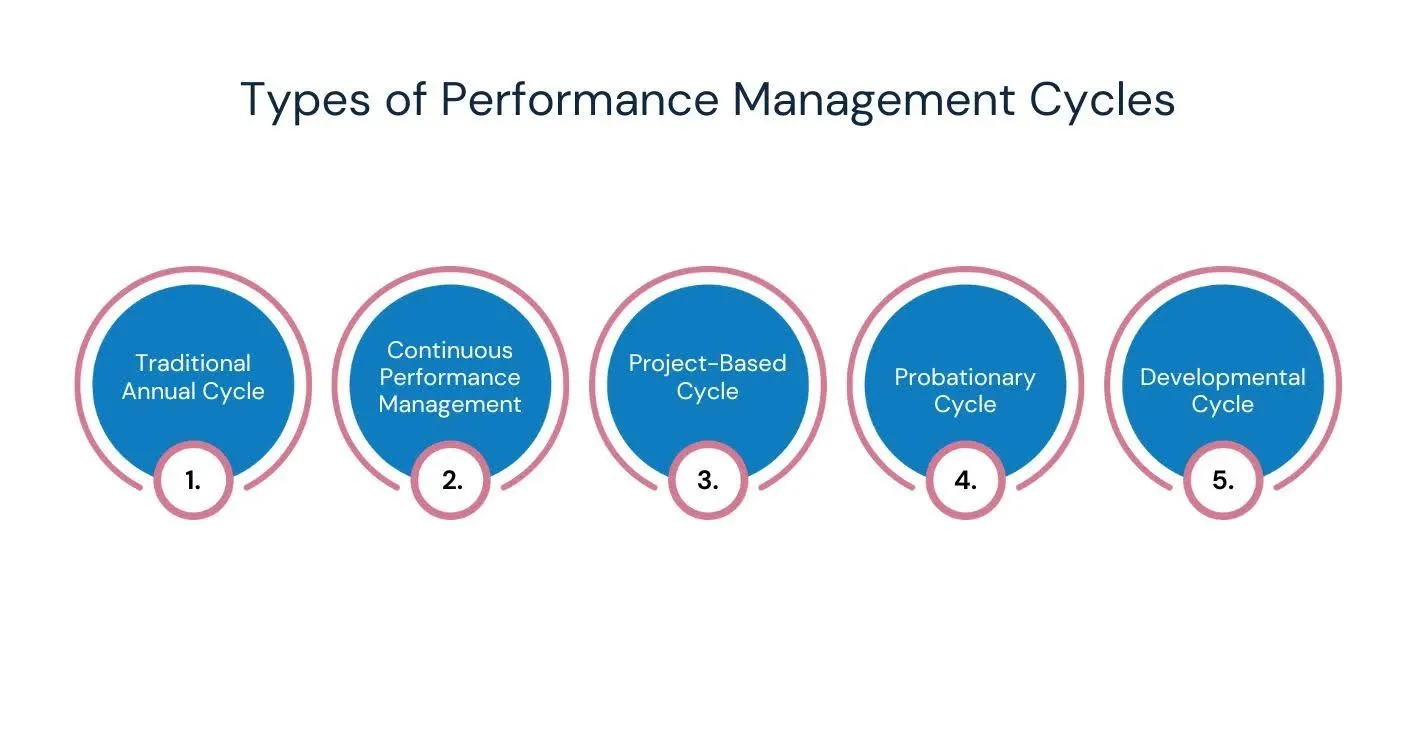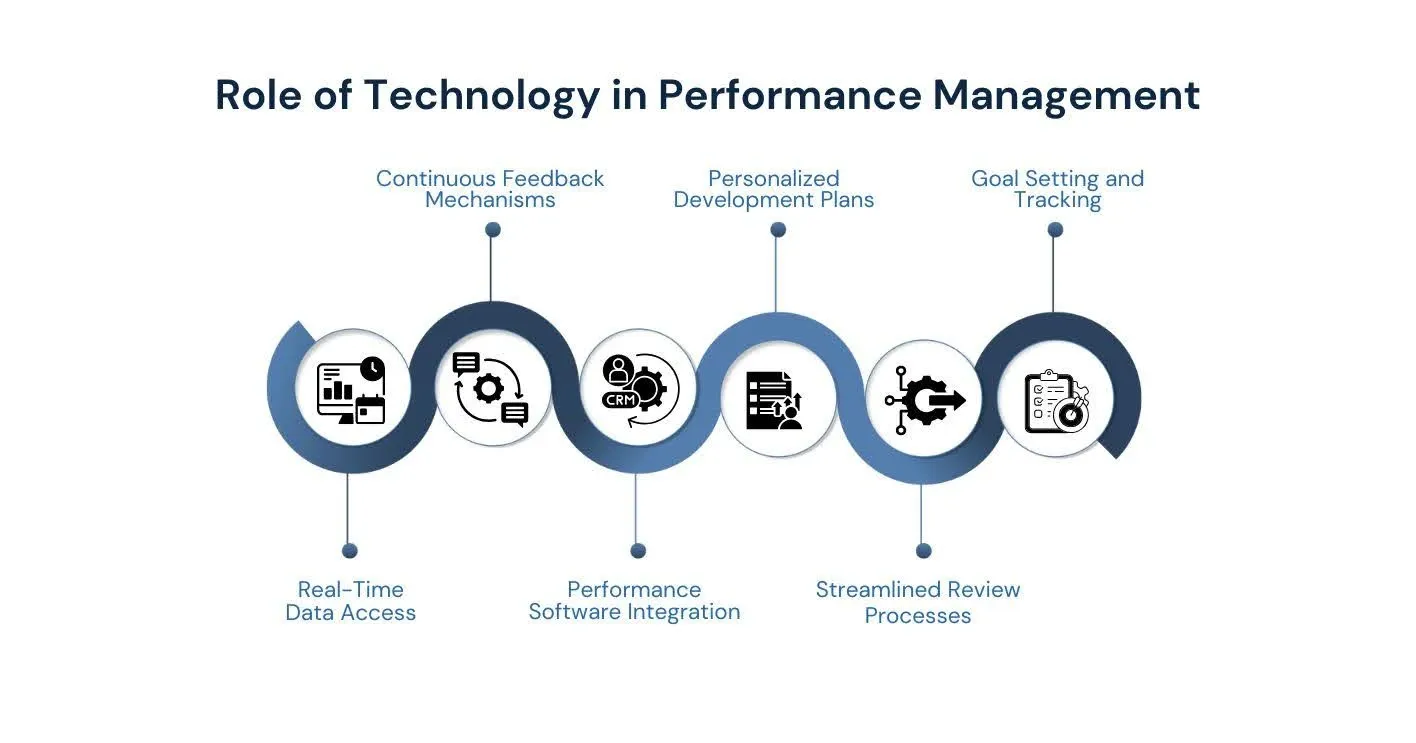
Performance management is a routine part of team operations, but the process often lacks structure or consistency. A 2025 report indicates that 45% of managers believe their formal performance review processes do not bring value to the company, despite 98% of organizations acknowledging the importance of performance management programs.
The performance management cycle offers a methodical approach to organizing this process into clear stages: goal setting, monitoring progress, reviewing results, and planning for development. Moving beyond annual reviews to include regular check-ins and feedback, the cycle helps managers and employees stay focused on meaningful work. The aim is not merely to evaluate but to support steady improvement through ongoing dialogue and clear expectations.
This blog analyzes each stage and explains how they work together over time. Rather than focusing only on annual reviews, the cycle supports regular check-ins and feedback that help managers and employees stay focused on the work that matters.
The performance management cycle is a structured, ongoing process that helps you and your team work toward shared objectives. It typically involves four stages: planning, monitoring, reviewing, and rewarding. Rather than relying solely on annual reviews, this approach encourages regular conversations and adjustments throughout the year, making it more adaptable to changing priorities and individual development needs.
The performance management cycle helps connect individual tasks to broader organizational objectives by setting clear expectations and providing consistent feedback. For example, a sales team might set quarterly targets that directly support the company's annual revenue goals. Regular check-ins allow for adjustments and keep everyone focused on the business's most important outcomes.
Regular feedback and development opportunities in your routine create a workplace where employees feel supported and valued. For example, recognizing a team member's effort on a challenging project can boost morale and motivate others to strive for excellence.
Additionally, when you provide clear pathways for growth and address performance issues constructively, you help build a culture of continuous learning and improvement. This approach enhances individual performance and contributes to overall organizational success.
By engaging in each stage of the performance management cycle, planning, monitoring, reviewing, and rewarding, you can create a dynamic environment that supports both individual and organizational growth.
A strong performance management cycle creates a steady rhythm of setting expectations, tracking progress, giving feedback, and recognizing results. This ongoing process keeps teams focused and adaptable.
Here are the main elements to keep in mind:
Focusing on these points creates a cycle that promotes steady improvement, open dialogue, and shared responsibility without overload or distraction.
The performance management cycle keeps daily work connected to broader business goals, preventing confusion and delays. It turns broad objectives, like improving customer satisfaction, into clear, measurable tasks and tracks progress regularly.
Ongoing communication replaces infrequent reviews, allowing timely feedback and adjustments that keep the team focused on steady improvement. This process also strengthens accountability, as everyone understands their responsibilities and can monitor their progress.
Early identification of skill gaps or productivity issues lets you provide support before problems grow. Recognizing achievements along the way boosts motivation and helps retain talent.
A consistent performance management cycle guides teams toward shared goals with clear expectations and regular feedback, helping the business run smoothly.

When managing employee performance, you can choose from various performance management cycles tailored to different organizational needs and structures. These types helps you select the most suitable approach for your team.
This approach involves setting goals at the beginning of the year, conducting a mid-year review, and finalizing with an annual performance appraisal. While straightforward, it may not provide timely feedback or adapt quickly to changing objectives.
In this model, you engage in regular check-ins, real-time feedback, and ongoing goal adjustments. This continuous dialogue supports agility and keeps employees aligned with evolving priorities.
Here, performance evaluations are tied to specific projects or assignments. After each project's completion, you assess outcomes, discuss lessons learned, and set objectives for future tasks. This cycle suits environments with short-term projects or dynamic workloads.
This cycle, used for new hires or employees in new roles, focuses on initial performance during a defined probation period. It includes setting short-term goals, frequent feedback sessions, and a final review to determine role suitability.
This type emphasizes personal and professional growth. You work with employees to identify development areas, set learning goals, and periodically review progress. It's beneficial for succession planning and skill enhancement.
By selecting the appropriate performance management cycle, you can better support your team's objectives and adapt to your organization's unique demands.
A well-structured performance management cycle comprises distinct stages that guide you and your team through setting expectations, monitoring progress, supporting development, and recognizing achievements. Understanding each component helps maintain clarity and consistency throughout the process.
You can create a transparent and supportive environment that encourages continuous improvement and aligns individual efforts with organizational success.
CompUp provides a unified platform that simplifies compensation planning, appraisal cycles, and performance tracking. We assist HR teams with features such as multi-level appraisal workflows, real-time budget simulations, and customizable dashboards. CompUp's benchmarking tools allow for creating compensation bands across various functions and levels, aiding clear communication of rewards and expectations.
The planning stage lays the groundwork for the entire performance management cycle. It’s where you and your team define clear, measurable goals that shape both daily work and long-term growth. A thoughtful approach at this stage helps clarify expectations and builds commitment.
Start with specific, measurable, achievable, relevant, and time-bound SMART goals. Instead of vague objectives like “improve customer service,” try “increase customer satisfaction scores by 10% in the next quarter.” This level of clarity helps define success from the start.
The OKR framework is a goal-setting method individuals, teams, and organizations use to focus efforts, track progress, and drive outcomes that matter. OKRs are specific, outcome-focused, concise, and numeric, helping teams prioritize, track success, and adapt quickly.
Make sure individual goals reflect broader business objectives. For instance, if the company plans to grow in new markets, a marketing team might focus on campaigns for targeted demographics in those regions.
Involve team members in shaping their goals. Employees who contribute to this process are more invested in the outcome. It also brings in valuable insights and helps set realistic targets.
Identify what each employee needs to meet their goals, whether that’s training, tools, or mentorship. Planning support in advance helps reduce roadblocks later.
Once goals are set, write them down and make sure everyone involved has access to them. Regularly revisiting these goals in check-ins helps track progress and make timely adjustments.
A solid planning stage provides direction, encourages ownership, and supports individual growth and team success.
This stage keeps you updated on progress and lets you address issues early. It’s about ongoing conversations that maintain momentum and clarify expectations, not just tracking numbers.
Hold frequent check-ins like weekly meetings or project updates. Early discussions help identify obstacles and find solutions quickly, for example, if a sales rep misses targets.
Focus feedback on behaviors or results, not personality. For instance, instead of “You’re not doing well,” say, “Client follow-up emails are delayed; let’s manage your schedule better.” Timely feedback supports quick course correction.
Invite employees to share their views. This builds trust and uncovers challenges or ideas you might miss.
Record progress and feedback to track patterns and support future decisions, for example, noting repeated delays to identify training needs.
Be open to revising goals when priorities change, like shifting marketing targets to digital engagement during unexpected events.
Consistent monitoring and open feedback keep the cycle adaptable, supporting steady improvement and avoiding surprises at review time.
This stage offers a formal chance to assess performance against set goals and discuss successes and challenges, helping guide future actions.
Hold focused sessions using objective data and documented feedback, concentrating on results instead of opinions. For example, review sales figures alongside customer feedback for a balanced view.
Check how results measure up to initial goals, highlighting successes and areas needing improvement. For instance, praise for customer satisfaction wins while addressing slow response times.
Encourage open talks about challenges or growth areas, uncover issues like resource gaps or unclear instructions, and plan necessary support or training.
Have employees evaluate themselves to promote reflection and identify skill gaps for targeted development.
Record discussions, agreed actions, and any adjustments to keep accountability and provide a reference for future cycles.
Approaching reviews as fact-based, collaborative conversations promotes ongoing progress instead of judgment.
Rewarding and recognition keep motivation high and reinforcing positive behaviors. Thoughtful acknowledgment makes an effort, and the results feel appreciated.
Connect rewards directly to achievements discussed in reviews. For example, recognizing a team that meets a project deadline while maintaining quality highlights desired standards.
Combine bonuses or promotions with informal praise, such as thank-you notes or verbal compliments. Even a simple “great job” in a meeting can boost morale.
Tailor recognition to each person; some prefer public praise, and others prefer private thanks or tangible rewards, making it more meaningful.
Acknowledge steady improvement as well as results. For example, praise employees who consistently raise customer satisfaction over time.
Encourage regular recognition at all levels, including peer-to-peer. Digital shout-outs or peer-nominated awards help embed appreciation into daily routines.
Rewards and recognition into the cycle help sustain motivation and highlights the value of contributions across the organization.
Each stage of the performance management cycle involves multiple contributors. Knowing who’s responsible for what helps you create clarity, keep momentum, and make space for open communication throughout the process.
You guide the process from start to finish. This includes setting clear goals, providing support, and tracking performance. Your role is part strategist, part coach. For example, you may work with an employee to set quarterly targets and then offer regular feedback as they work toward them. During reviews, you assess progress and help identify development opportunities.
Each team member takes an active role. They contribute to setting personal goals, following through on plans, requesting feedback, and reflecting on their own performance. For example, an employee in a marketing role might propose a new campaign as part of their goals and later analyze the results to discuss during evaluation. Their input helps shape both outcomes and growth.
HR supports the structure. You help design the process, provide tools (like performance tracking systems or review templates), and guide consistency across teams. HR might also aid manager training or mediate when performance discussions get off track. Your oversight helps the process run smoothly without taking over the day-to-day responsibility.
Leadership sets the direction and tone. You connect team goals to broader business priorities and model how performance is discussed. For instance, by sharing how your performance is evaluated or recognized, you reinforce the idea that feedback and progress apply to everyone, not just junior roles.
Team members often provide informal feedback and support throughout the cycle. In some workplaces, peer reviews or 360-degree feedback play a more structured part. For example, a colleague may offer insights during a review, highlighting collaboration skills or problem-solving you might not have directly observed.
By clarifying these roles, you balance the performance management cycle, so it’s not just a top-down process but a shared effort shaped by input and accountability across all levels.

Technology streamlines processes, provides real-time insights, and facilitates continuous feedback. Here's how you can integrate technology into each stage of the performance management cycle:
Performance management software allows you to access up-to-date information on employee progress. For instance, if a team member's performance metrics dip, you can quickly identify the issue and address it without waiting for periodic reviews.
Digital platforms enable ongoing communication between managers and employees. Instead of relying solely on annual reviews, you can provide timely feedback, acknowledge achievements, or address concerns as they arise.
Bringing performance management tools into your workflow helps you simplify tasks, create consistency across teams, and spend less time on admin work. These tools support every phase of the performance management cycle, from planning to recognition, without adding complexity to your day.
Technology aids the creation of tailored development programs. By assessing individual performance data, you can design specific training modules or career progression paths that align with each employee's strengths and areas for improvement.
Automated systems simplify the performance review cycle by scheduling evaluations, sending reminders, and compiling relevant data. This automation reduces administrative burdens and ensures that reviews are conducted consistently and efficiently.
Digital tools assist in setting clear, measurable goals and tracking progress toward them. This transparency ensures that managers and employees are aligned on expectations and can monitor achievements over time.
These technological solutions into your performance management practices allows you to create a more dynamic, responsive, and efficient system that supports employee growth and organizational success.
Despite its importance, the performance management cycle often encounters obstacles that hinder its effectiveness. Recognizing these challenges allows you to address them proactively and maintain a productive work environment.
When objectives are vague or not well-communicated, employees may struggle to understand what is expected of them. This confusion can lead to misaligned efforts and decreased productivity. For instance, if a sales team is told to "increase client engagement" without specific targets or strategies, they may focus on activities that don't contribute to the desired outcome.
Relying solely on annual reviews can leave employees without timely insights into their performance. Without regular feedback, minor issues may go unaddressed and escalate over time. For example, an employee unaware of a recurring mistake may continue the behavior, leading to larger problems that could have been corrected with earlier intervention.
Personal biases can inadvertently influence performance assessments, resulting in unfair evaluations. A manager might favor an employee with similar interests, overlooking objective performance metrics. This favoritism can demotivate other team members and erode trust in the evaluation process.
Managers may struggle to provide constructive feedback or set achievable goals without proper training. For instance, a manager unfamiliar with effective communication techniques might deliver feedback perceived as overly critical, leading to employee dissatisfaction.
Using obsolete or incompatible performance management tools can impede the evaluation process. Such systems may lack features that facilitate real-time feedback or integration with other platforms. For example, a tool that doesn't allow for easy progress tracking can make it challenging to monitor goal attainment, leading to inefficiencies.
Failing to acknowledge employee achievements can result in decreased motivation and engagement. When hard work goes unnoticed, employees may feel undervalued. For instance, if a team consistently meets project deadlines without receiving any recognition, their enthusiasm and commitment may wane over time.
Employees may hesitate to accept feedback, especially if it's delivered infrequently or lacks specificity. This resistance can stem from fear of criticism or past negative experiences. For example, an employee who previously received vague feedback might be skeptical about its usefulness, leading to disengagement from the evaluation process.
By identifying and addressing these challenges, you can refine your performance management cycle to support your team's growth and success better.
CompUp offers a suite of tools to support organizations in managing the performance management cycle. Here's how CompUp can assist:
By integrating these functionalities, CompUp aids organizations in maintaining an effective performance management cycle, contributing to overall organizational efficiency and employee satisfaction.
The performance management cycle remains structured to guide employee development, set expectations, and review outcomes. Organizations benefit from greater clarity and continuity when each phase, planning, monitoring, reviewing, and developing, is treated as part of an ongoing conversation rather than a set of isolated tasks.
While many models exist, the most durable systems are those tailored to the workplace's rhythms and values, not copied from standard templates. Regular reflection on the process itself also helps refine how goals are set and how feedback is delivered. Rather than treating performance management as an annual obligation, treating it as a rhythm of work allows both employees and managers to focus on development that holds up over time.
CompUp supports this ongoing approach to performance management with tools built for consistency and clarity. CompUp helps teams stay on course throughout the year. Its flexible setup allows managers to structure reviews and development plans that fit their team’s working style without relying on rigid, one-size-fits-all templates. Get CompUp today.
1. How can cultural differences impact the performance management cycle in global teams?
Cultural norms influence communication styles, feedback acceptance, goal-setting preferences, and definitions of "good performance." For example, employees in high-context cultures may value indirect feedback, while low-context cultures prefer directness. A rigid cycle that doesn't adapt to these nuances can lead to disengagement and misinterpretation.
2. What role does emotional intelligence play in each stage of the performance management cycle?
Emotional intelligence (EI) enhances the effectiveness of goal setting, feedback delivery, and performance evaluations. Leaders with high EI are better at motivating employees, resolving conflicts during reviews, and coaching underperformers without demoralizing them.
3. How can technology negatively affect performance management if not implemented carefully?
Over-reliance on software can depersonalize the process, reducing valuable face-to-face interaction and making feedback feel transactional. Poorly designed systems may also introduce bias or reduce transparency, especially if employees don’t understand how data is collected or used.
4. What are the hidden costs of skipping the 'development planning' stage in the cycle?
Without structured development planning, employees may stagnate, disengage, or seek growth elsewhere. It also creates a talent pipeline gap, where organizations face succession risks and must resort to expensive external hiring.
5. Why is the 'planning' phase often more important than the 'review' phase?
Poor goal planning leads to irrelevant or misaligned reviews. If objectives aren’t SMART (Specific, Measurable, Achievable, Relevant, Time-bound), performance assessments can become subjective or misleading, resulting in unfair evaluations and reduced employee trust.

Customer Success Manager
Driven with the aim of becoming a valuable subject matter expert in the world of Total Rewards to be able to deliver exceptional customer experiences.
Revolutionizing Pay Strategies: Don't Miss Our Latest Blogs on Compensation Benchmarking